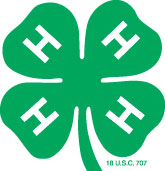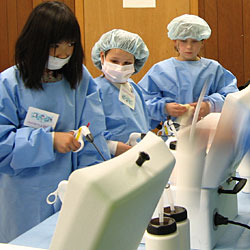
- What is 4-H?
- What is the mission of 4-H?
- Isn't 4-H just for kids who live on farms?
- What is a 4-H club?
- What happens in a 4-H club?
- What age must you be to join 4-H?
- Does it cost money to join 4-H?
- How did 4-H originate?
- Where does 4-H get its funding?
- Who "runs" the 4-H program?
- What do the four H's on the 4-H emblem stand for?
- What is the 4-H pledge?
- What is the 4-H motto?
- What is the 4-H slogan?
- Where are 4-H programs found?
- Is 4-H in my county?
- How can I find out more about 4-H in my county?
1. What is 4-H?
4-H is an informal, practical educational program for youth. It is the youth development program of Rutgers Cooperative Extension, the off-campus division of the New Jersey Agricultural Experiment Station of Rutgers University. 4-H is where there's fun in learning and learning in fun!
2. What is the mission of 4-H?
The Rutgers Cooperative Extension 4-H Youth Development program uses a learn-by-doing approach to enable youth to develop the knowledge, attitudes, and skills they need to become competent, caring, and contributing citizens of the world. This mission is accomplished by using the knowledge and resources of the land-grant university system, along with the involvement of caring adults.
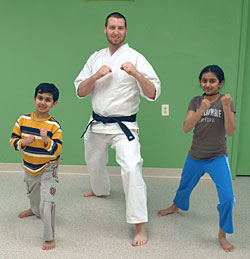
3. Isn't 4-H just for kids who live on farms?
No! 4-H is for all youth, wherever they live--on farms, in suburbs, in cities. 4-H serves youth from all backgrounds and interests. It reaches both boys and girls through 4-H clubs, special-interest groups and short-term projects, school-age child care, individual & family learning & mentoring, camping, and school enrichment. Most 4-H members are from towns and cities and they participate in contemporary projects such as bicycle care and safety, consumer education, aerospace and model rocketry, go-carting, and animal sciences. 4-H offers membership without regard to race, color, national origin, sex, disability, or handicap.
4. What is a 4-H club?
Clubs are the foundation of the 4-H program. A 4-H club is a group of five or more youngsters guided by one or more adult volunteer leaders. A club can be any size from a small group of kids from one neighborhood to a larger club consisting of youth from all over the county.
5. What happens in a 4-H club?
A 4-H club usually concentrates on one or more projects such as gardening, woodworking, small animals, food and nutrition, karate, photography, etc. 4-H members build leadership by electing officers and conducting their own business meetings; work together on community service activities; meet new friends; and most important, have lots of fun.
6. What age must you be to join 4-H?
Youth, grades 4-13 (one year out of high school), can be standard 4-H club members and enroll in many different 4-H projects. Members of this age may exhibit their completed work to be judged for awards. Youth, Kindergarten-3rd grade, can be 4-H Cloverbud members. The 4-H Cloverbud program is a noncompetitive learning experience. Usually, Cloverbud members are in separate clubs where they sample a variety of 4-H projects. Older 4-H members also have special opportunities, such as serving on a county-wide 4-H teen council.
7. Does it cost money to join 4-H?
4-H has no membership registration fee. Uniforms are not required. Most 4-H project information, activities, and events are free-of-charge or available at cost, which is usually minimal. Each club chooses whether to charge dues.
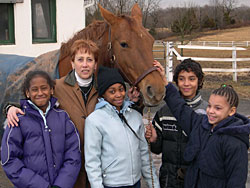
8. How did 4-H originate?
4-H clubs were preceded by corn clubs for boys and canning clubs for girls, organized in the early 1900's by public school educators who wanted to broaden the knowledge and experience of their students. 4-H became an official part of the Cooperative Extension Service, along with agriculture and home economics, at about the time Cooperative Extension was officially established by the U.S. Congress in 1914. The term "4-H Club" first appeared in a federal document in 1918, and by the mid-1920s, 4-H was well on its way to becoming a significant national program for youth. 4-H is an American idea that has spread around the world. Throughout its long history, 4-H has constantly adapted to the ever-changing needs and interests of youth.
9. Where does 4-H get its funding?
Rutgers Cooperative Extension, of which 4-H is a part, receives funds from a cooperative partnership of three levels of government: federal (the U.S. Department of Agriculture's National Institute of Food and Agriculture), state (via the New Jersey Agricultural Experiment Station of Rutgers, the State University of New Jersey), and county (through the county Board of Chosen Freeholders). 4-H also receives support from private sources.
10. Who "runs" the 4-H program?
Volunteers are the key to providing 4-H programs for youth. Capable, interested adult volunteers are always needed to lead clubs and to assist with 4-H activities. Orientation is provided, so no previous experience is necessary. 4-H volunteers are supported by a professional staff, including a county 4-H agent who is a faculty member of Rutgers University. The county 4-H agent is responsible for the county-wide 4-H program and also has state and national responsibilities. There are various county 4-H support and advisory groups made up of interested adult volunteers. State and national 4-H personnel assist county 4-H professionals.
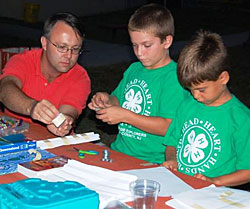
11. What do the four H's on the 4-H emblem stand for?
The 4-H emblem is a green four-leaf clover with a white 'H' on each leaflet, symbolizing Head, Heart, Hands, and Health. The 4-H emblem was patented in 1924.
12. What is the 4-H pledge?
At 4-H club meetings and other 4-H events, 4-H members recite the Pledge of Allegiance and this 4-H pledge:
I pledge my Head to clearer thinking,
my Heart to greater loyalty,
my Hands to larger service,
and my Health to better living,
for my club, my community,
my country, and my world.
13. What is the 4-H motto?
"To Make the Best Better."
14. What is the 4-H slogan?
"Learn by Doing."
15. Where are 4-H programs found?
4-H programs are conducted in 3,150 counties of the United States, and also in the District of Columbia, Guam, Puerto Rico, and the Virgin Islands. In addition, more than 80 countries around the world have youth programs similar to 4-H, with an overall enrollment of about 10 million young people.
16. Is 4-H in my county?
Yes! 4-H is in every county in the state. In New Jersey, thousands of members are in hundreds of local 4-H clubs. Thousands more are involved in 4-H through school enrichment, short-term programs, and camping. In addition, thousands of adults volunteer their time to assist with the 4-H program. You can become part of 4-H by contacting your county 4-H office.
17. How can I find out more about 4-H in my county?
Contact the 4-H staff in the Rutgers Cooperative Extension office in the county where you live. Check out County Offices.

